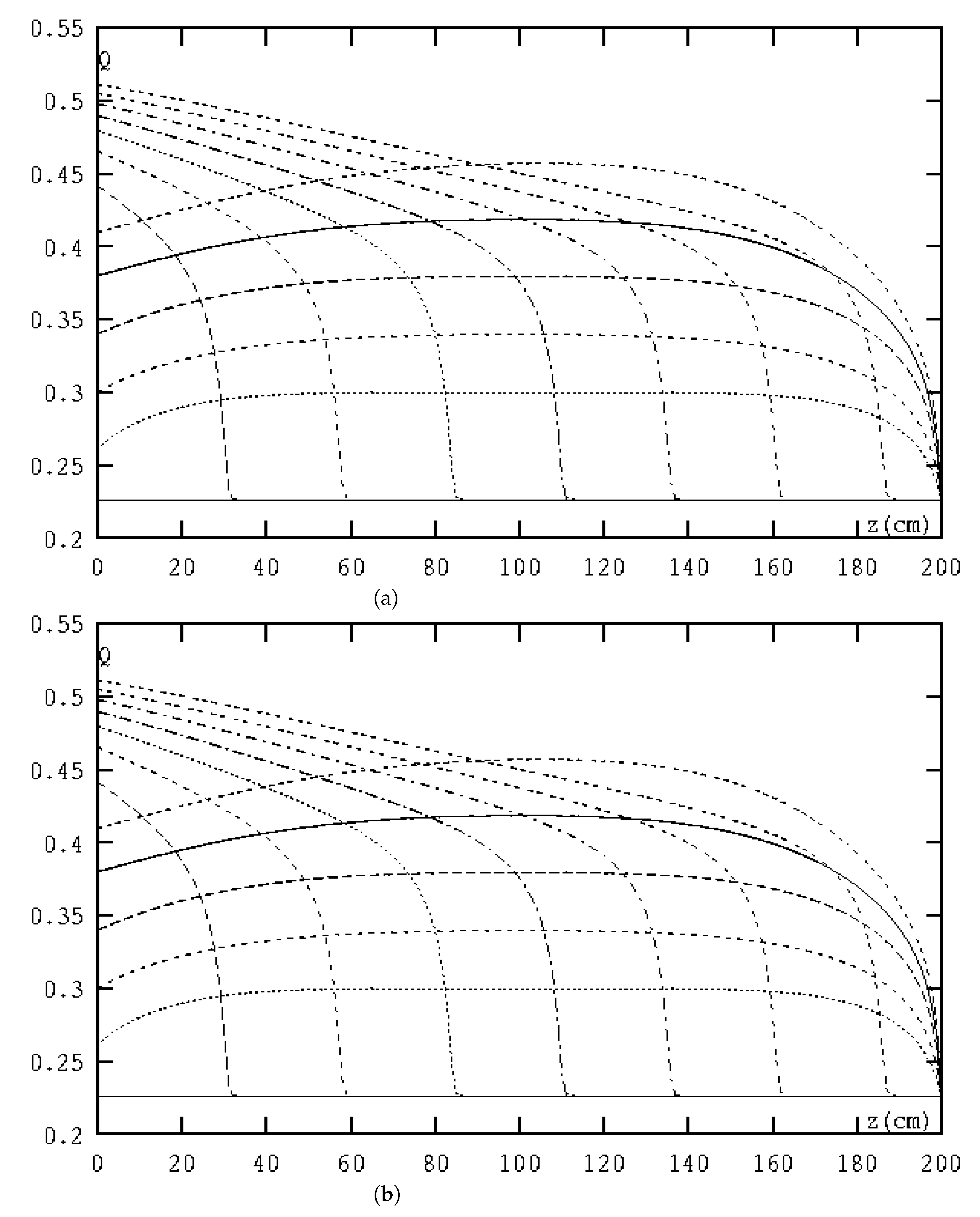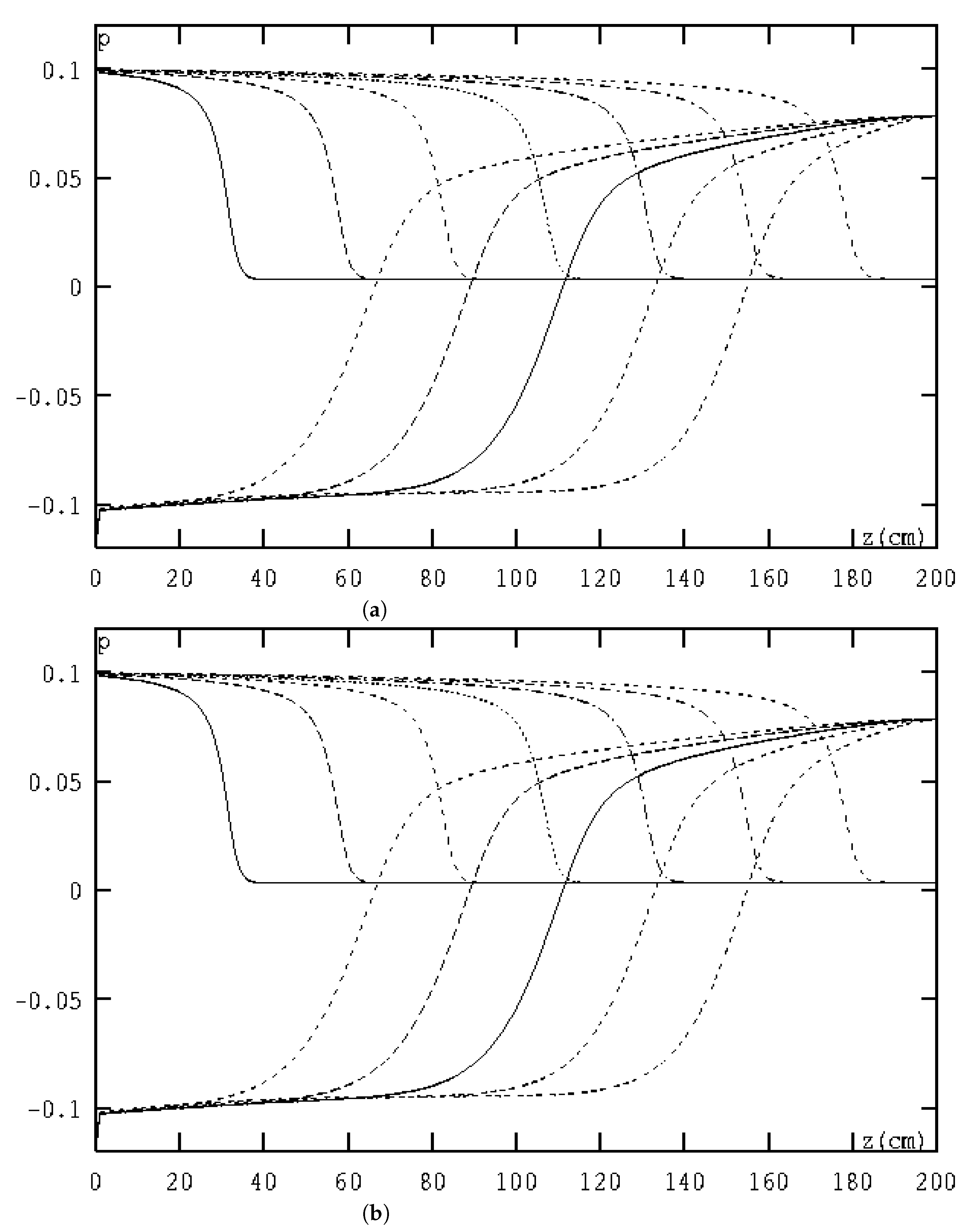A Preserving Precision Mixed Finite Element Dimensionality Reduction Method for Unsaturated Flow Problem
Abstract
:1. Introduction
2. The Classical MFE Method for the Unsaturated Flow Problem
2.1. The Functional Form of MFE Format for the Unsaturated Flow Problem
2.2. The Matrix Representation of MFE Format for the Unsaturated Flow Problem
3. The PPMFERD Method for the Unsaturated Flow Problem
3.1. Structure of POD Basis Vectors
3.2. The Creation of PPMFERD Format for the Unsaturated Flow Problem
3.3. The Error Analysis of PPMFERD Solutions
4. Some Numerical Simulations for the Unsaturated Flow Problem
5. Discussions
6. Conclusions and Discussions
Author Contributions
Funding
Institutional Review Board Statement
Informed Consent Statement
Data Availability Statement
Conflicts of Interest
References
- Rahimi, A.; Rahardjo, H.; Leong, E. Effect of range of soil-water characteristic curve measurements on estimation of permeability function. Eng. Geol. 2015, 185, 96–104. [Google Scholar] [CrossRef]
- Li, Y.; Vanapalli, S.K. Models for predicting the soil-water characteristic curves for coarse and fine-grained soils. J. Hydrol. 2022, 612, 128248. [Google Scholar] [CrossRef]
- Yoon, S.; Chang, S.; Park, D. Investigation of soil-water characteristic curves for compacted bentonite considering dry density. Prog. Nucl. Energ. 2022, 151, 104318. [Google Scholar] [CrossRef]
- Dai, Y.J.; Zeng, Q.C. A land surface model (IAP94) for climate studies, Part I: Formulation and validation in off-line experiments. Adv. Atmos. Sci. 1997, 14, 433–460. [Google Scholar]
- Ye, D.Z.; Zeng, Q.C.; Guo, Y.F. Contemporary Climatic Research; Climatic Press: Beijing, China, 1991. (in Chinese) [Google Scholar]
- Bear, J. Dynamics of Fluids in Porous Media; American Elsevier Publishing Company: New York, NY, USA, 1972. [Google Scholar]
- Lei, Z.D.; Yang, S.X.; Xie, S.C. Soil Hydrodynamics; Tsinghua University Press: Beijing, China, 1988. (in Chinese) [Google Scholar]
- Xie, Z.H.; Zeng, Q.C.; Dai, Y.J.; Wang, B. Numerical simulation of an unsaturated flow equation. Sci. China Ser. D 1998, 41, 429–436. [Google Scholar] [CrossRef]
- Xie, Z.H.; Zeng, Q.C.; Dai, Y.J.; Wang, B. Application of finite element method to unsaturated soil flow problem. Climate Environ. Res. 1998, 28, 73–81. [Google Scholar]
- Luo, Z.D.; Xie, Z.H.; Zhu, J.; Zeng, Q.C. Mixed finite element method and numerical simulation for the unsaturated soil water flow problem. Math. Numer. Sin. 2003, 25, 113–128. [Google Scholar]
- Luo, Z.D.; Chen, G. Proper Orthogonal Decomposition Methods for Partial Differential Equations; Academic Press of Elsevier: San Diego, CA, USA, 2018. [Google Scholar]
- Alekseev, A.K.; Bistrian, D.A.; Bondarev, A.E.; Navon, I.M. On linear and nonlinear aspects of dynamic mode decomposition. Int. J. Numer. Meth. Fluids 2016, 82, 348–371. [Google Scholar] [CrossRef]
- Du, J.; Navon, I.M.; Zhu, J.; Fang, F.; Alekseev, A.K. Reduced order modeling based on POD of a parabolized Navier-Stokes equations model II Trust region POD 4D VAR data assimilation. Comput. Math. Appl. 2013, 65, 380–394. [Google Scholar] [CrossRef]
- Li, H.R.; Song, Z.Y. A reduced-order energy-stability-preserving finite difference iterative scheme based on POD for the Allen-Cahn equation. J. Math. Anal. Appl. 2020, 491, 124245. [Google Scholar] [CrossRef]
- Li, H.R.; Song, Z.Y. A reduced-order finite element method based on proper orthogonal decomposition for the Allen-Cahn model. J. Math. Anal. Appl. 2021, 500, 125103. [Google Scholar] [CrossRef]
- Song, Z.Y.; Li, H.R. Numerical simulation of the temperature field of the stadium building foundation in frozen areas based on the finite element method and proper orthogonal decomposition technique. Math. Method Appl. Sci. 2021, 44, 8528–8542. [Google Scholar] [CrossRef]
- Zhu, S.; Dede, L.; Quarteroni, A. Isogeometric analysis and proper orthogonal decomposition for parabolic problems. Numer. Math. 2017, 135, 333–370. [Google Scholar] [CrossRef]
- Kunisch, K.; Volkwein, S. Galerkin proper orthogonal decomposition methods for a general equation in fluid dynamischs. SIAM J. Numer. Anal. 2002, 40, 492–515. [Google Scholar] [CrossRef]
- Li, K.; Huang, T.Z.; Li, L.; Lanteri, S.; Xu, L.; Li, B. A Reduced-Order Discontinuous Galerkin Method Based on POD for Electromagnetic Simulation. IEEE Trans. Antennas Propag. 2018, 66, 242–254. [Google Scholar] [CrossRef]
- Hinze, M.; Kunkel, M. Residual based sampling in POD model order reduction of drift-diffusion equations in parametrized electrical networks. J. Appl. Math. Mech. 2012, 92, 91–104. [Google Scholar] [CrossRef] [Green Version]
- Stefanescu, R.; Navon, I.M. POD/DEIM nonlinear model order reduction of an ADI implicit shallow water equations model. J. Comput. Phys. 2013, 237, 95–114. [Google Scholar] [CrossRef] [Green Version]
- Zokagoa, J.M.; Soulaǐmani, A. A POD-based reduced-order model for free surface shallow water flows over real bathymetries for Monte-Carlo-type applications. Comput Methods Appl. Mech. Eng. 2012, 221-222, 1–23. [Google Scholar] [CrossRef]
- Baiges, J.; Codina, R.; Idelsohn, S. Explicit reduced-order models for the stabilized finite element approximation of the incompressible Navier-Stokes equations. Int. J. Numer. Methods Fluids 2013, 72, 1219–1243. [Google Scholar] [CrossRef]
- Luo, Z.D. The reduced-order extrapolating method about the Crank–Nicolson finite element solution coefficient vectors for parabolic type equation. Mathematics 2020, 8, 1261. [Google Scholar] [CrossRef]
- Luo, Z.D.; Jiang, W.R. A reduced-order extrapolated technique about the unknown coefficient vectors of solutions in the finite element method for hyperbolic type equation. Appl. Numer. Math. 2020, 158, 123–133. [Google Scholar] [CrossRef]
- Zeng, Y.H.; Luo, Z.D. The reduced-dimension technique for the unknown solution coefficient vectors in the Crank–Nicolson finite element method for the Sobolev equation. J. Math. Anal. Appl. 2022, 513, 126207. [Google Scholar] [CrossRef]
- Luo, Z.D. A finite element reduced-dimension method for viscoelastic wave equation. Mathematics 2022, 10, 3066. [Google Scholar] [CrossRef]
- Luo, Z.D. The dimensionality reduction of Crank–Nicolson mixed finite element solution coefficient vectors for the unsteady Stokes equation. Mathematics 2022, 10, 2273. [Google Scholar] [CrossRef]
- Yang, X.Y.; Luo, Z.D. An unchanged aasis function and preserving accuracy Crank-Nicolson finite element reduced-dimension method for symmetric tempered fractional diffusion equation. Mathematics 2022, 10, 3066. [Google Scholar] [CrossRef]
- Fukunaga, K. Introduction to Statistical Recognition; Academic Press: New York, NY, USA, 1990. [Google Scholar]
- Lumley, J.L. Coherent Structures in Turbulence, Transition and Turbulence; Meyer, R.E., Ed.; Academic Press: New York, NY, USA, 1981; pp. 215–242. [Google Scholar]
- Jolliffe, I.T. Principal Component Analysis; Springer: Berlin/Heidelberg, Germany, 2002. [Google Scholar]




| Soil Types | /(mm) | /(mms) | b | ||
|---|---|---|---|---|---|
| 1 | 0.33 | 30 | 0.2000 | 3.5 | 0.088 |
| 2 | 0.36 | 30 | 0.0800 | 4.0 | 0.119 |
| 3 | 0.39 | 30 | 0.0032 | 4.5 | 0.151 |
| 4 | 0.42 | 200 | 0.0130 | 5.0 | 0.266 |
| 5 | 0.45 | 200 | 8.9 | 5.5 | 0.300 |
| 6 | 0.48 | 200 | 6.3 | 6.0 | 0.332 |
| 7 | 0.51 | 200 | 4.5 | 6.8 | 0.378 |
| 8 | 0.54 | 200 | 3.2 | 7.6 | 0.419 |
| 9 | 0.57 | 200 | 2.2 | 8.4 | 0.455 |
| 10 | 0.60 | 200 | 1.6 | 9.2 | 0.487 |
| 11 | 0.63 | 200 | 1.1 | 10.0 | 0.516 |
| 12 | 0.66 | 200 | 0.8 | 10.8 | 0.542 |
| t | n | MFE Method | PPMFERD Method | ||
|---|---|---|---|---|---|
| CPU Runtime | CPU Runtime | ||||
| 210 h | 21 | 4462s | 62 s | ||
| 420 h | 42 | 8926s | 121 s | ||
| 630 h | 63 | 13393s | 182 s | ||
| 840 h | 84 | 17860s | 240 s | ||
Publisher’s Note: MDPI stays neutral with regard to jurisdictional claims in published maps and institutional affiliations. |
© 2022 by the authors. Licensee MDPI, Basel, Switzerland. This article is an open access article distributed under the terms and conditions of the Creative Commons Attribution (CC BY) license (https://creativecommons.org/licenses/by/4.0/).
Share and Cite
Luo, Z.; Li, Y. A Preserving Precision Mixed Finite Element Dimensionality Reduction Method for Unsaturated Flow Problem. Mathematics 2022, 10, 4391. https://doi.org/10.3390/math10224391
Luo Z, Li Y. A Preserving Precision Mixed Finite Element Dimensionality Reduction Method for Unsaturated Flow Problem. Mathematics. 2022; 10(22):4391. https://doi.org/10.3390/math10224391
Chicago/Turabian StyleLuo, Zhendong, and Yuejie Li. 2022. "A Preserving Precision Mixed Finite Element Dimensionality Reduction Method for Unsaturated Flow Problem" Mathematics 10, no. 22: 4391. https://doi.org/10.3390/math10224391





